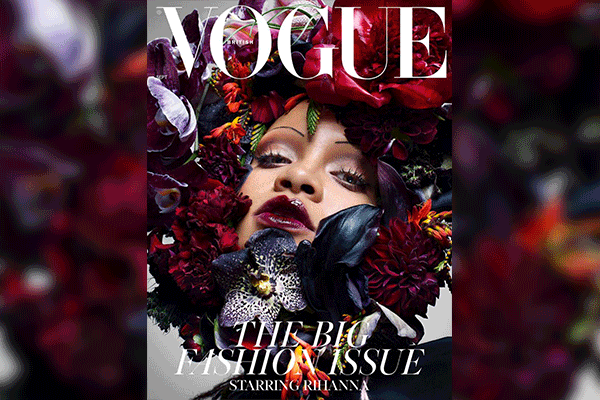Beyoncé. Rihanna. Yara Shahidi. Tiffany Haddish. Tracee Ellis Ross. Lupita Nyong’o. Zendaya. Slick Woods. Issa Rae. Aja Naomi King. Laverne Cox. Naomi Campell.
In an unprecedented move, almost all of the cover stars on the coveted September issues of mainstream fashion magazines – including Vogue, Glamour and Elle – are black.
September 2018 is clearly the month of #BlackGirlMagic, with the 12black women listed above covering the fashion industry’s biggest (both in physical size and importance) issue of the year.
Beyonce wears a white Gucci dress and floral headdress from Rebel Rebel in one cover image for Vogue’s September issue.
Tyler Mitchell/Vogue
Even InStyle, which featured Jennifer Aniston on its primary cover for the September issue, tried to get in on the tail end of the action by including Dutch Moroccan-Egyptian model Imaan Hammam on one of their subscriber covers.
It’s a powerful statement on beauty, blackness and recognizing cultural tastemakers. Highlighting black women who not only run the gamut in skin tone, hair texture and build, but who are also leaders in their industries, is impressive. It’s exciting and brings hope to a year that has felt like a dumpster fire more often than not.
Having Nyong’o, with her darker skin and natural short crop, on the cover of Porter magazine’s “Desire Issue” or putting trans actress and activist Laverne Cox on Variety’s cover would have been unheard of years ago. That’s power.
“Until there is a mosaic of perspectives coming from different ethnicities behind the lens, we will continue to have a narrow approach and view of what the world actually looks like,” Beyoncé said in her Vogue cover story, which was photographed by Tyler Mitchell, the first black photographer to shoot American Vogue’s cover in the publication’s nearly 126-year history.
That narrow approach seems to be changing: The new issue of British Vogue boasts both the magazine’s first black editor-in-chief, Edward Enniful (who emigrated to London from Ghana), and its first black September cover girl, Rihanna (who was born In Barbados). The Elle Canada issue that Ross covers was produced by the only black editor-in-chief in the Elle network, Vanessa Craft. Under her leadership, six of the last 11 issues have featured women on color on the cover.
But that change, while welcome, has been slow: the crop of September issues comes 53 years after Donyale Luna made history as the first black woman to appear on the front of a magazine with her Harper’s Bazaar cover in 1965. The following year, she became the first black woman to appear on the cover of British Vogue. (American Vogue wouldn’t do it until 1974 with Beverly Johnson.)
Essence magazine hinted at this slow change for their peers when they announced their own September cover, featuring Naomi Campell wearing Dapper Dan for Gucci and interviewed by Andre Leon Talley. “Giving Black women covers since May 1970,” the magazine tweeted.
And there are certainly valid critiques about majority white-run legacy magazines using black women and black culture to score ad dollars and clout points on the biggest issue of the year, while not actually walking the walk or talking the talk within the walls of their publications or in the fashion industry in general.
Perhaps even more important than a September issue cover is the work that remains to be done behind the scenes. That is what is needed if the magazine industry is to accomplish more than meeting a diversity goal or having a resident black woman who can tap them into the conversation on Black Twitter. This is where representation truly matters: Having black people at every level of a publication is what will allow black people to tell their stories honestly and to mass audiences.
And if the data is any indication, tapping into the loyalty and buying power of black people is a lucrative decision. According to a Nielsen report from February on black impact, black consumers have an outsized spending power, and “research shows that Black consumer choices have a ‘cool factor’ that has created a halo effect, influencing not just consumers of color but the mainstream as well.”
Black women can sell an issue. Black people can make positive history and a resounding impact if the opportunities are just … there. For me, the positive benefits of visibility on the 2018 September covers exceed the criticism and bolster the push for more.
As Beyoncé said in her Vogue cover story, “If people in powerful positions continue to hire and cast only people who look like them, sound like them, come from the same neighborhoods they grew up in, they will never have a greater understanding of experiences different from their own.”
The beauty of all the various shades of black and brown on the covers is only matched by what’s inside the book: thoughtful and insightful interviews with range.
Beyoncé, Haddish and King discuss physical and mental health; Zendaya opens up about using her platform “to show you how much beauty there is in the African-American community”; Cox and Shahidi talk activism and the political landscape; Ellis Ross addresses aging and self-love.
People are taking notice. Everyone from LeBron James to Ross, who herself is on a cover, are spotlighting the September 2018 phenomenon, and there’s hope that this isn’t a one-off or a “trend” (considering blackness doesn’t end after a season).
James wrote in an Instagram post: “Thank you all for continuing to not settle and setting great examples in life for so many looking up to you for inspiration/guidance and love!”
Outside of the also important topics of FUPAs and c-sections and c-suites, Beyoncé didn’t mince her words about black people being on magazine covers. “When I first started, 21 years ago, I was told that it was hard for me to get onto covers of magazines because black people did not sell,” she said. “Clearly that has been proven a myth.”
Based on this month alone, “clearly” is right.
https://www.instagram.com/p/BmPGiNZjp-_/?utm_source=ig_embed&utm_campaign=embed_loading_state_control
















